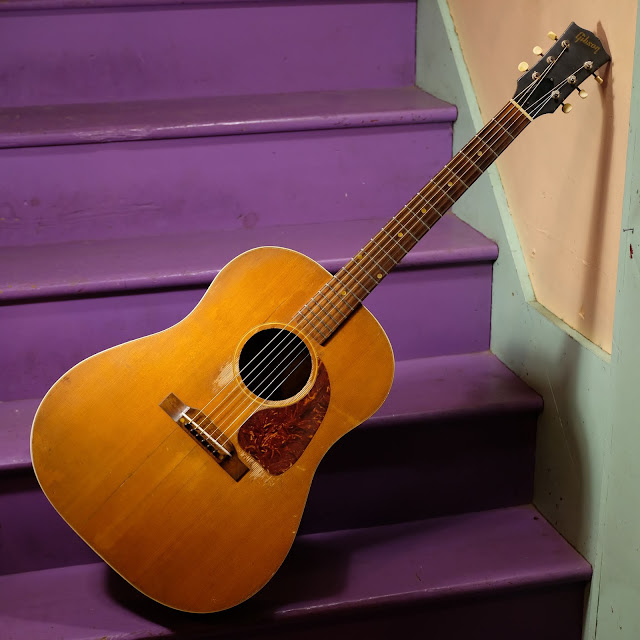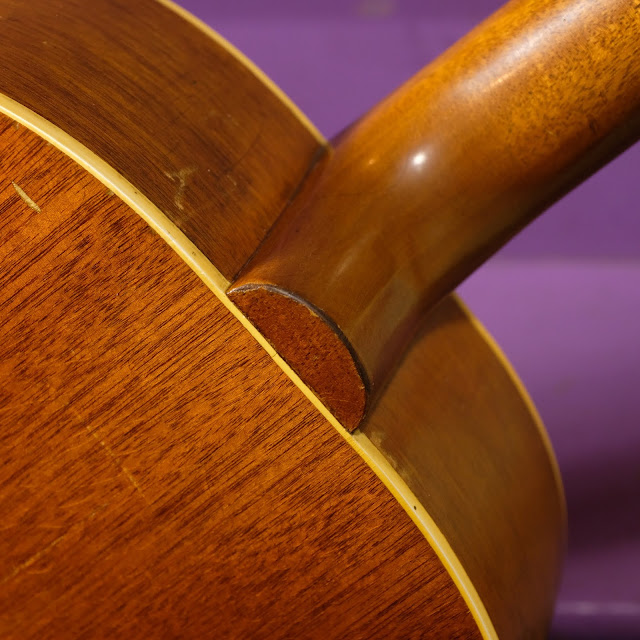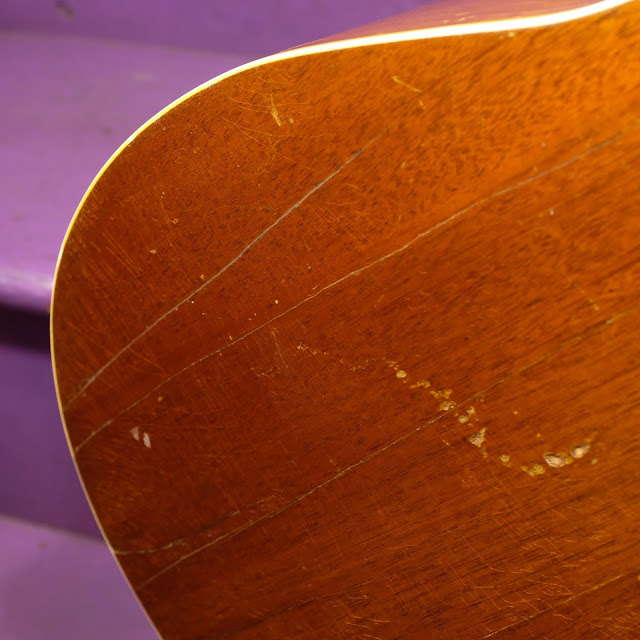1951 Gibson J-50 Slope Dreadnought Guitar
This beautiful old bruiser is actually owned by a lefty. He and I hemmed and hawed about converting this instrument to lefty, but in the end he's decided to put it up for sale. I concur -- it would be awfully hard to come to the point of yanking the pickguard and filling and recutting the saddle slot on the bridge, among other things -- because it just looks so grand.
It also happens to be original, too, save the saddle, bridge pins, and endpin. It has this great, well-loved, well-played, earned-respect kind of look to it what with all of its pickwear lovebites and assortment of repaired cracks throughout. It's a slugger!
Tone-wise it's dry, clean, woody, and carries very well with a good punch. The bass is tight but warm and present and the mids and highs are thick and zap your ears out front. It makes a great flatpicking instrument for a player that likes to dig-in and avoid a "compressed" sound, though it also makes a clean, folksy-sounding, country-blues fingerpicker as well. I don't think the soundclip does it justice, but it does give you an idea of the tone.
Work included: a fret level/dress, hairline crack cleating on the back (the top and side cracks were already cleated in a non-pro but common-sense manner), new compensated bone saddle (it has a spare, taller, nicely-cut compensated saddle, too), and general setup and adjustments. It has a straight neck, the truss works as it should, the frets are fairly low but have decent height/life in them, and it plays with spot-on action at 3/32" EA and 1/16" DGBE at the 12th fret. I have it strung with 54w, 42w, 32w, 24w, 16, 12 strings and it's going strong.
Scale length: 24 13/16"
Nut width: 1 11/16"
String spacing at nut: 1 1/2"
String spacing at saddle: 2 1/8"
Nut width: 1 11/16"
String spacing at nut: 1 1/2"
String spacing at saddle: 2 1/8"
Body length: 20 1/8"
Lower bout width: 16 1/8"
Upper bout width: 11 1/2"
Lower bout width: 16 1/8"
Upper bout width: 11 1/2"
Side depth at endpin: 4 7/8"
Top wood: solid spruce
Back/sides wood: solid mahogany
Neck wood: mahogany
Fretboard: rosewood
Back/sides wood: solid mahogany
Neck wood: mahogany
Fretboard: rosewood
Neck shape: ~12" radius fretboard, medium-C-shaped neck profile
Bridge: original rosewood
Nut: original synthetic
Saddle: new bone, compensated
Condition notes: original finish throughout but it's only glossy/remains cleaner on the back. The top, sides, and neck all show a dulling of the original finish and plenty of usewear and weather-check/finish crackle all over -- as well as plenty of scratching. There's a lot of pickwear around the soundhole and below the pickguard. Someone played the heck out of this!
It comes with: a newer, Gibson-brand dreadnought case.
The hairline cracks in the top are plentiful but they've all been repaired in the past. There's one long one running from the back of the bridge to the lower bout and one traveling half that distance and mirroring it below the treble side of the bridge. The remaining cracks are a "pickguard shrinking crack, one 3" hairline near the fretboard extension on the bass side, and one small one running from the end of the fretboard into the soundhole.
The original bridge is in good health and by some minor twist of fate, the saddle slot is actually in the correct location. How about that?
The back is a curious, glossy-looking finish. It's clearly original but it's interesting that the rear hasn't suffered the major dulling that the front and sides have.
The original Kluson tuners are still going strong.
The back cracks are longer and stranger. It has one very long one up the treble side of the back and then three cracks clustered together on the lower bout. While there were a couple of ancient cleats, my cleating work remained focused on the back -- so now the longer hairlines aren't a liability anymore as they're all good to go.
The last, worst crack was repaired in the past and is a "endpin crusher" damage. Someone must've knocked the guitar on the endpin and it split the sides. Either way, they're all glued-up as much as they could be in the past, and now they're filled and a little sturdier, too.



























Comments